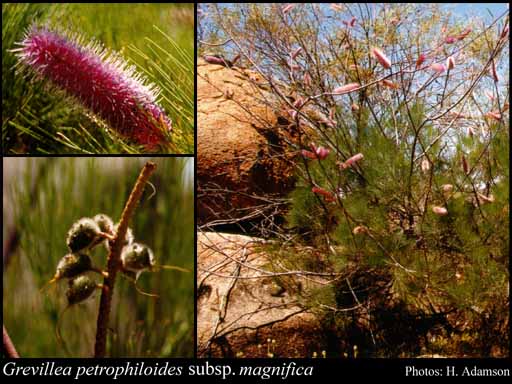- Reference
- New Names Grevillea 11 (1986)
- Conservation Code
- Not threatened
- Naturalised Status
- Native to Western Australia
- Name Status
- Current
Shrub (with emergent flowering branches), to 4 m high. Fl. pink, Jun to Aug. Deep to skeletal granitic loams. Bases of granite outcrops or crevices.

Scientific Description
Shrubs, 2-4 m high; branchlets glabrous or hairy, with a glaucous bloom. Leaves alternate, 180-250 mm long, hairy, on the abaxial surface, the hairs straight; lamina flat, once divided, pinnately divided, divided to the midrib; lobes 30-120 mm long, 0.5-1 mm wide, the margins recurved or revolute, enclosing the lower surface of the leaf blade, forming a groove either side of the midvein. Inflorescences axillary or terminal, red or pink; pedicels 1-3 mm long. Perianth 8-10 mm long; tepals some joined and some free after flower opens, glabrous; ovary hairy or glabrous, stipitate, the stipe 1-2 mm long; pistil 16-21.5 mm long, white, red or pink, pollen presenter conical, style hairy or glabrous. Follicles glandular hairy, viscid, dehiscent, 7-9 mm long. Flowers in June, July or August. Occurs in the South-west (SW) Botanical Province(s), in the Avon Wheatbelt (AW) or Mallee (MAL) IBRA subregion(s).
Distribution
- IBRA Regions
- Avon Wheatbelt, Mallee.
- IBRA Subregions
- Merredin, Western Mallee.
- Local Government Areas (LGAs)
- Kellerberrin, Lake Grace, Quairading.